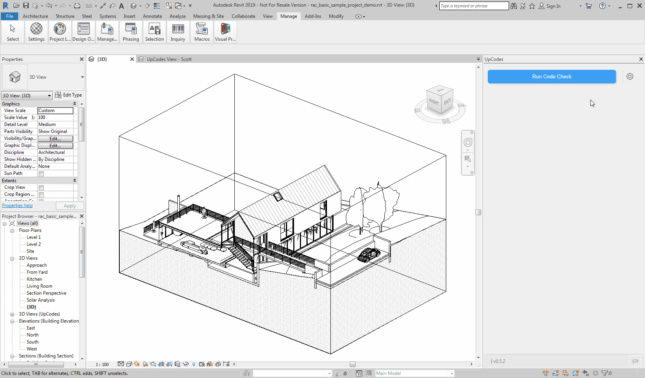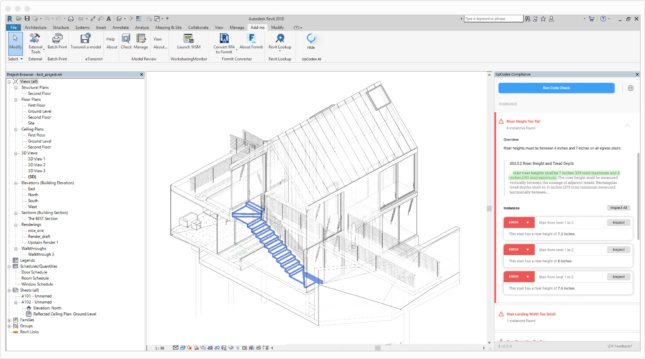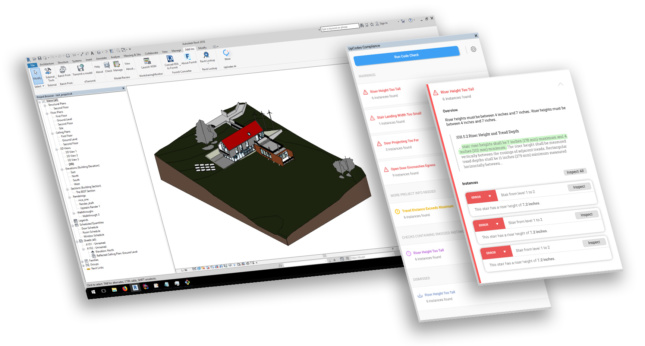Potential productivity benefits for architecture, engineering, and construction may depend on the outcome of copyright litigation by the International Code Council (ICC) against San Francisco-based startup UpCodes. The firm, which aims to reduce perceived bottlenecks in the implementation of the nation’s 93,000 building codes, faces charges that its public posting of codes undermines the public-private partnership that develops them.
The nonprofit ICC, which prepares the International Building Code and other model codes adopted by multiple jurisdictions, contends that UpCodes has appropriated its property and “does not need to violate ICC’s copyrights to further its claim to innovate,” an anonymous ICC spokesperson commented for this article through its public relations firm. UpCodes regards its practice as fair use, citing precedents establishing that information “incorporated by reference” into law (the applicable legal term) enters the public domain. Other appeals courts, ICC counters, have protected copyrights in cases it considers comparable.
The suit involves a tension that jurists have long recognized in copyright law: the need for material support and incentive for creators (who have exclusive rights “for limited times” under the Constitution’s copyright clause) versus the need to prevent monopoly control from stifling the circulation of ideas. The conflict pits ICC’s interests in codebook development and sales, and its assertion that its website already provides adequate access, against UpCodes’ interests in expanding access and linking codes with building information modeling (BIM) systems.

Brothers Scott and Garrett Reynolds, the first formerly an architect with KPF and the latter an engineer with construction-software firm PlanGrid, founded UpCodes in 2016 to streamline the often-tedious aspects of code review. Automating this process, they contend, can reduce errors and free up architects’ attention and time. Opposing ICC’s don’t-fix-what-ain’t-broke legal position, Scott Reynolds commented, “I think it actually is a broken system.” An estimated multi-billion-dollar annual expenditure “goes into construction rework due to compliance errors, so there’s a huge amount of wasted expenditure simply from code mistakes.”
He is not alone in finding code review laborious. The Economist, citing McKinsey Global Institute findings on the $10 trillion construction industry’s historically low productivity, advocates standardizing codes, alongside steadier public infrastructure investment and incentives for BIM adoption, as strategies to modernize the sector. The National Association of Home Builders estimates that 24.3 percent of the final price of an average new single-family house, over $84,000, is attributable to regulation, with an even higher burden, 32.1 percent, for multifamily developments.
UpCodes, supported by the prominent seed accelerator Y Combinator, offers two products out of beta as of May 2019: UpCodes Web, a searchable code repository, and the extension UpCodes AI, a Revit add-in that analyzes 3D digital models and provides real-time compliance checks. The web product is the target of ICC’s suit. The AI product uses the code database as its foundation, automatically synchronizing with code updates; it is often compared to editorial tools like spellcheckers and Grammarly, or the Lint analytic utility for Unix. A key feature of UpCodes AI, Garrett Reynolds notes, is that “checking models in 3D is orders of magnitude easier than checking 2D plans… For example, stair headroom clearance is pretty difficult to tell in a 2D plan, but in a 3D, we can just draw a box and check for intersections.”
The ICC views UpCodes as infringing on a successful process that makes U.S. buildings safe, balancing efficient standardization with adaptability to local conditions. Its statement notes that the organization “develops the model codes through a rigorous, transparent, consensus-driven process involving nearly 55,000 industry sector members and over 9,500 government agency members. It provides free access to view the codes on its website. The sale and licensing of the codes to professionals and governmental organizations defrays the cost of the code production process.”
“The Code Council’s position is that incorporation into law does not terminate the copyright in the Code Council’s model codes,” the statement continues, adding that “UpCodes—a for-profit company—is trying to solve a problem that does not exist because the Code Council already makes its model codes freely available to all to read on its website.”
The ICC’s website and some jurisdictions, Scott Reynolds allows, offer online access to codes, but not in practical form. “You can’t copy. You can’t paste. You can’t print,” he says. “You just can’t work with the text. You can simply have read-only access, and from a professional standpoint, or [for] a homeowner, that just doesn’t suit the needs that you have. And then there’s even jurisdictions like Michigan where you can’t access the code; they don’t host free access.” Such limitations, he argues, amount to constriction of the very processes ICC claims to promote. They arguably border on privatizing the law: “If you are legally bound to follow rules of the government, and you will face civil and criminal penalties if you don’t, you have to be able to read those rules. They can’t be put behind a paywall.”
“The key distinction in these cases is not whether something is a code or not but whether it’s legally binding,” noted Mitch Stoltz, an intellectual-property attorney with the Electronic Frontier Foundation (EFF), supporting the Reynoldses’ position with a historical comparison. “Supposedly the Roman emperor Caligula would write the laws in small print and hang them up very high, so no one could actually read them. That’s a problem for democracy.” The EFF is not involved in the ICC–UpCodes suit but is defending the nonprofit organization Public Resource in a similar case involving publication of documents from three standards-development organizations: the American Society for Testing and Materials, National Fire Protection Association, and American Society of Heating, Refrigerating and Air-Conditioning Engineers.
ICC’s charge that loss of copyright could impair code development, Stoltz adds, does not square with the underlying economics. “They are happy to make money by rationing access to codes,” he said, but “their business model in the end doesn’t depend on that, because the actual work of creating these codes [in] most industries is done by volunteers from that industry and from the government. They’re not paying people to write the things. People are coming together voluntarily to write them.”
The Reynoldses emphasize that UpCodes is not meant to put code specialists out of business, but to help more people implement codes properly and safely. “We really wanted to democratize the process of code research and empower all individuals or professionals to navigate through that process themselves,” Scott said. “The first thing we tell a user is, UpCodes AI is not a replacement for a professional code consultant,” Garrett added, noting that “spellcheck doesn’t put editors out of work.” He described the ICC’s work as “really important, and we want them to continue doing it. Their main revenue stream actually isn’t from selling books of the law. It actually comes from program services: things like consulting, accreditation, training, consulting.”

An initial co-plaintiff, the American Society of Civil Engineers (ASCE), withdrew from the suit but maintains that its materials are copyrighted and describes its economic model differently. Alexa Lopez, ASCE’s senior manager for public affairs and media relations, provided a written comment: “Upcodes is a for-profit entity that posted these copyrighted materials online for profit. For awareness, ASCE is a 501(c)(3) non-profit organization with a long history of promoting the education, science and profession of civil engineering. ASCE expends significant resources on standards development, including convening staff and volunteer experts from across the country and globe, compliance with ANSI standards, public input, and balloting. ASCE recoups some of these costs through standards sales, the proceeds of which are used to promote the Society’s educational and charitable 501(c)(3) activities. The Society’s standards are protected by copyright and registered with the U.S. copyright office.”
The most relevant precedent, the Reynoldses and their allies hold, is Veeck v. Southern Building Code Congress International, Inc., 293 F.3d 791 (5th Cir. 2002), where the Fifth Circuit Court of Appeals held that model codes developed by the SBCCI (one of three organizations that merged to form the ICC in 1994), once enacted into law, forfeited copyright protection. An earlier case, Building Officials & Code Adm. [BOCA] v. Code Technology, Inc., 628 F.2d 730, 734 (1st Cir. 1980), also defined Massachusetts building codes as law not protectable by copyright.
The ICC’s position distinguishes between legislatively-generated laws and model codes developed through public-private partnerships, pointing to decisions in which copyrights incorporated by reference were preserved for other privately created information, such as the American Medical Association’s procedure-coding system, or a used-car valuation guide mentioned in insurance regulations. Stoltz contrasts Veeck, where code was explicitly made part of the law, with the used-car price book case (CCC Information Services, Inc. v. Maclean Hunter Market Reports, Inc., 44 F.3d 61 (1994)): “The court said that didn’t put that book in the public domain. But that’s different from saying ‘This document establishes rules for fire safety in the construction of an office building, and it is hereby incorporated into this regulation’”
To Garrett Reynolds, ICC’s action is “a suit where they said, ‘Let’s try to kill them out of the gate.’ I think they thought they could bury us in litigation costs, and they have succeeded in that strategy many times” with other firms. Scott noted that of the three groups that formed ICC, “one of those three is SBCCI, and then another one of those three is BOCA. So, two of those three organizations have already litigated the case and lost. But now it’s a new entity, and they can threaten, and they can litigate again. So yeah, I do think it’s a tactic of intimidation.”

Architects contacted for comment describe UpCodes as a time-saver, though not a panacea.
Rob Pivovarnick, AIA, a senior project architect at Michael Graves Architecture & Design and an early adopter of UpCodes AI, has found the program useful, though not without a few false-positives—e.g., mistaking 20-inch stadium stairs, meant for seating rather than walking, for ordinary steps limited by code to a seven-inch height. It is particularly helpful, he said, in checking ADA-compliant bathroom details.
“It looks for the ambulatory stall, it checks returning spaces, it checks for accessible sinks and toilet-seat heights.” He is careful to manage expectations: “There’s no software out there that you’re going to unleash and say, ‘This thing is doing my code review,’ and they make that clear on their website…. I don’t think UpCodes or Revit are ever going to preclude the use of a code consultant on a job. There’s just too much information there for somebody to build a pro piece of software that’s going to run all those checks.” Yet, since UpCodes is currently free of charge, “if it catches one thing, then it’s valuable,” he added. “[It] can be a $100,000 problem if the toilet room isn’t big enough to hold the ambulatory stall, and then it gets built, and then walls need to move and plumbing needs to change.”
Depending on what price point UpCodes eventually chooses for individual or network licenses for its AI product, Pivovarnick speculated, it may be a valuable investment. At a previous firm he used MADCAD, a program that centralizes codes from ICC and other organizations, largely on a paid basis; he finds UpCodes more flexible, especially in the field. “Instead of having to remember the code section, I can type stairs or firewall or fire partition and things like that, and it brings up all the relevant sections, which is great.”
The ICC’s statement includes a description of its efforts in the digital realm: “We have worked with our members and partners to harness a variety of innovative ideas to take advantage of breakthroughs in technology, such as MADCAD.com, and will continue to do so. Paramount, however, is ensuring that the public continues to have confidence that buildings are being constructed according to the most modern codes and safety standards.” If Pivovarnick’s experience is representative, free digital instruments are already performing more nimbly than their paid equivalents. It now falls to the courts to determine whether a copyright in this disruptive realm hinders or advances aims that all parties share.











